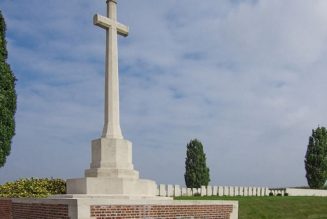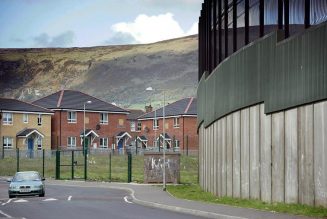In the early 1970s, as the United States began preparing for its Bicentennial, Boston decided that the U.S.S. Constitution would be a focal point of the city’s anniversary celebrations, with a new museum to the celebrated warship opening at the Charlestown Navy Yard.
The three-masted heavy frigate, launched in 1797, was named by George Washington and built with copper bolts forged by Paul Revere. Black-sided and red-bottomed, with a single, stark white running stripe, Constitution protected American ships against the French in the undeclared Quasi-War of 1798-1800 and quelled pirate attacks in the Mediterranean during the First Barbary War. The armed vessel defeated five British warships in the War of 1812, and it was in the wake of one of those battles—in which the American crew watched enemy cannonballs bounce harmlessly off Constitution’s white-oak hull—that the warship earned its famous nickname: “Old Ironsides.”
Constitution fulfilled its last mission, seizing a slave ship near the Congo River, in 1853 but remains today a fully commissioned warship of the U.S. Navy and—225 years after its launching— the oldest warship still afloat anywhere on Earth, moored in Boston Harbor’s chilly waters.
In 1906, after decades of work as a training ship along the east coast, the Navy made its first attempt to restore Constitution to its original War of 1812 configuration. In order to maintain the ship’s seaworthiness, a near-full restoration would need to be undertaken every 10 years.
But when the Navy went looking for materials to repair Constitution ahead of the 1976 Bicentennial, the enormous white oaks needed for the restoration of Old Ironsides were hard to find in the Northeast, so supervisors at the Boston Naval Shipyard scoured the Midwest and eventually bought timber from a private seller in Ohio.
“Someone in the Navy caught wind of it and wondered why they didn’t just come another four or five hours west, where they had fantastic white oak right on Navy property that they could have gotten for free,” recalls Trent Osmon, the environmental manager at Naval Support Activity (NSA) Crane, a Navy installation 35 miles southwest of Bloomington, Indiana.
That pricey decision prompted the Navy in 1976 to begin harvesting white oak for the U.S.S. Constitution at NSA Crane. To celebrate the occasion, they established Constitution Grove, a ceremonial 40-acre dedicated section of forest on the sprawling base where much of the timber that keeps the formidable warship afloat is harvested. Today, NSA Crane is the only forest in the U.S. managed by the Navy to support its fleet.
Out of Missile Range
It’s absolutely understandable, of course, that the Bicentennial hunters of Constitution’s timbers wouldn’t think a modern naval base may be the ideal place to source planks for a 225-year-old warship, but NSA Crane—the third-largest naval installation in the world by geographic area and 700 miles from the nearest ocean—is an unlikely place for the Navy.
NSA Crane had its origins in the 1930s with the New Deal, when the U.S. government purchased impoverished and often unfarmable land, including 40,000 acres of hills that would be reforested for the purpose of creating jobs. Soon, workers would plant a wide variety of oak, hickory, poplar, maple, and ash trees across the acres of Crane.
In 1939 with the beginning of WWII, the Navy—whose weapons and munitions at the time were housed in Delaware—was in search of a location west of the Allegheny mountains and beyond the reach of a possible waterborne enemy attack to store its ordnance.
“A carrier-based bombing raid could have wiped out 100 percent of the Navy’s weaponry,” says Osmon.
After identifying southern Indiana as a “geographically safe spot” from enemy missiles, the government added another 30,000 acres to its 40,000 acres of forested hills to create NSA Crane. The first administrative buildings on the base were dedicated in December 1941—just a few days before the attack on Pearl Harbor.
Over the next three decades, Crane’s focus evolved from ordnance production, testing, and storage—where weapons and rounds were housed in subterranean magazines throughout the forest—to weapons and ordnance development. In the late 60s and early 1970s, the Department of Defense decided to centralize its ordnance storage with the U.S. Army, and the Navy’s focus at NSA Crane shifted to special weapons development.
As the ordnance magazines buried across the 108-square miles of naval installation began to dwindle at NSA Crane, the Navy created a forest management program with an eye toward harvesting more than 50,000 acres of the base that had been reforested during the New Deal.
Constitution Grove
In one corner of NSA Crane’s expanse of white oak trees is the 40-acre area known as Constitution Grove. The white oak trees are tall and slender, with branches that start high in the trunk, culminating in a canopy that blocks most sunlight from reaching the ground.
This part of the forest was originally selected by the Navy due to its high concentration of high-quality white oak. And while Osmon and his crew harvest trees from across the Navy base for use on Constitution, most of it is tagged and felled right in Constitution Grove.
After felling what it needs for Constitution’s upkeep, the Navy sells the rest of its harvest to private furniture and piano makers, and, thanks to tylosis—the unique cell structure that makes white oak waterproof—bourbon cask-making for distillers just a short drive south in Kentucky’s famed bourbon country.
Roughly 25 percent of the forest’s annual growth in NSA Crane is harvested per year, a point of sustainable pride for Oson. “Forest management, when done properly, can provide you a resource forever,” he says. “It’s renewable. But if you clear-cut an entire forest and build a Walmart parking lot, well, that’s it for that forest.”
“The wood is sold by the Navy and the money goes back into the forestry program,” he adds. “In other words, you couldn’t have some warmonger come in and clear-cut the whole forest to build a new battleship.”
U.S.S. Constitution
Maintenance of a 225-year-old, 304-foot-long wooden warship is a constant job, and in the 50-odd years that Constitution Grove has supplied timbers for the maintenance of Constitution, Osmon estimates that 114 white oaks have been felled for the two most recent dry-dock restorations of Old Ironsides.
In a dry-dock restoration, Constitution is lifted out of the water for examination and repairs of its wooden hull below the waterline under the watchful eye of Robert Murphy, the production manager at Naval History and Heritage Command, Detachment Boston. Then the copper sheathing that protects the submerged section of vessel is removed, allowing Murphy’s team to more closely study the normally submerged section of the hull, looking for sections to repair and potentially replace. Armed with that knowledge, and knowing exactly how much wood Constitution will need, Murphy’s team contacts Osmon with an order for how many trees to fell for restoration of the storied warship.
In felling trees for Old Ironside’s hull planks, Osmon’s forestry team seeks out mature trees anywhere from 110 to 125 years old and 120-130 feet tall, which are then loaded on commercial trucks and taken to New England. There, the ship’s caretakers mill the enormous white oaks into hull planks that stretch up to 40 feet long, with leftover pieces repurposed for more ornamental flourishes around the ship, such as handrails and trim.
Murphy’s most recent request from NSA Crane came last April, and Osmon’s team had to hold off until the fall, when the protected long-eared bat moves from the forest to hibernate in area caves. Cutting crews lumbered carefully through NSA Crane’s forest with their heavy machinery, cutting the mighty white oaks, loading them on commercial trucks, and driving them up to Robert Murphy in Boston. There they were milled into planks to replenish Old Ironsides’ hull, ensuring that the warship will continue its service to the Navy for a third straight century.
Join Our Telegram Group : Salvation & Prosperity








